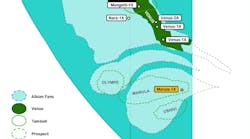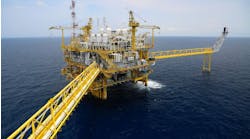Pemex's new Gulf of Mexico Project includes exploration
and development in 100-2,000 meter water depths
David Shields
Contributing Editor - Latin America
The discovery of new oil fields in water depths of 100-500 meters in Campeche Bay was announced recently by an official of Petroleos Mexicanos (Pemex)s exploration and production subsidiary.
The subsidiary's offshore area office is preparing to develop the new producing structures already identified in water depths of over 100 meters, where Pemex has never ventured into production before, as new techniques in well development, completion, and repairs have to be assimilated first by the company, said Carlos Rasso, Pemex's subdirector of production.
Rasso spoke at a forum on technological advances in exploration and production at the Mexican Petroleum Institute, Mexico City, in August.
The new fields, as usual, have Mayan names: Le, Zazil-Ha, Ayin, Makech, Chuktahs, Kaxan, Ib, and Kayab, among others.
The official stated that there is an extensive deepwater area in Campeche Bay where further discoveries are to be expected. Exploration in this area will take place within the framework of Pemex's new Gulf of Mexico Project, which will include exploratory and development work in increasing water depths, moving progressively from 100 meters to 2,000 meters, in the coming years.
Due to increasing domestic consumption of oil and to export obligations, development of the newly discovered, deepwater fields will be necessary before the end of the century, Rasso assured. Pemex must therefore, begin to gain experience in such work.
The subsidiary, known as Pemex-Exploration & Production (PEP), has already drawn up several development projects for these fields. Deepwater drilling and well completion work can be carried out through turnkey drilling contracts, which can be put out to tender as investment projects, he said.
Rasso told his audience that the basic technological difference between shallow-water and deepwater drilling is that in the former the wellhead rests on fixed structures above water level, while in the latter it is supported on the seabed. He estimated drilling costs would be $14.3 million for a vertical well and between $17.1 and $17.6 million for a directional well.
Meanwhile, Pemex's CEO, Adrian Lajous, announced the successful completion of the first directional well in the Campeche offshore area currently under exploitation. The well, known as Cantarell 2074, will provide an estimated flow of 10,000 b/d of heavy crude.
Cantarell is the main offshore production complex in the bay and has been the mainstay of Mexican oil production since 1980. Total output in the complex is close to a million b/d of 20-22 API crud and 430 mpc/d natural gas, which is about half of total output in Campeche Bay.
The well was completed on August 21st at a depth of 4,025 meters, including 300 meters of directional drilling. Drilling was successful in all regards, according to Pemex, which highlights reductions in costs achieved by not having to drill three or four vertical wells to obtain the same output. The well is still in the test stage, but its output should be significantly greater than in surrounding conventional wells.
It is the first of four directional wells being drilled in the Cantarell complex at a total cost of $25 million. Results of drilling on the second well were expected at the end of September.
It is also widely rumored that the offshore area office of PEP will undergo a wide-ranging restructuring. The office, known as the Marine Region, based in Ciudad del Carmen, will be split in two, to be known as Marine Region North and Marine Region South.
Essentially, the Marine Region North will take charge of Cantarell and other mainly heavy crude producing fields in Campeche Bay, while the Marine Region South will be in control of the light crude fields that lie marginally to the south of the heavy crude fields, an area where quite a number of new field development projects are underway.
The new structure is supposed to allow for simpler, transparent, more efficient administration in the offshore area, according to Pemex sources. Pemex's subdirector of technical services, Antonio Acua Rosado, will head the Marine Region North, while Luciano Flores Plauchu, currently in charge of the whole Marine Region, will direct the Marine Region South.
Copyright 1995 Offshore. All Rights Reserved.


